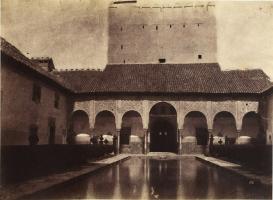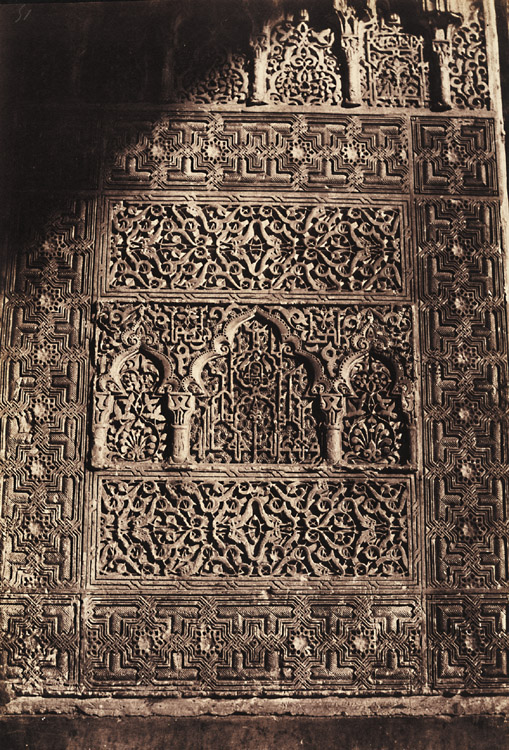
Self Portrait from a Glass Plate
Alphonse De Launay, or Delaunay as he sometimes wrote it, was born in 1827 in Manche, which is the most westerly Département of Normandy in France. This area had long been home to the De Launay family, which could track its roots back to 1610. His father had been an officer in the French Marines and was in the honor guard of the Emperor Napoleon I in 1813, although the family was apparently not of the nobility.
When he was young, De Launay apparently rejected the prestigious position of Inspector at la Compagnie de la Vieille-Montagne in order to pursue more artistic endeavors, including traveling, the arts and writing. He reportedly traveled to Spain in 1851 and 1854, and the paper negatives that he made there amazed many of his contemporaries in photography. Most of his larger Spanish images were of sun swept landscapes and architectural majesty, including images of Seville, Toledo, Madrid, Granada, Burgos, Valladolid, Segovia, and possibly Cordova. His travels also took him across the Mediterranean to Algeria to the cities of Algiers and Oran, where he also made photographs on his trip in 1854. He made a few primitive ethnographic studies of Spanish costumes in 1851, but the existing prints appear to be printed a bit later than the larger negatives and by De Launay himself in albumen prints made about 1860. At least one of the photographs was used as a study for a painting by a Seville painter by the name of Barieras. Copies of his paintings were also included with the group.
De Launay was undoubtedly a student of the noted French artist-photographer Gustave Le Gray and may have known several other photographers, including other Le Gray students, F.E. Le Dien and Theodore de Banville. The latter---as had De Launay--planned to be involved with the Theatre de la Rue de la Sante, just as the theater went bankrupt. De Launay's work in Algeria had been confused with Le Dien's work until just recently when images attributed to Le Dien appeared with De Launey's signature on them. His early larger photographs were paper negatives, probably waxed in the Le Gray style, that were then printed by Le Gray or his studio as albumenized salt prints. These stunning and newly rediscovered albumenized salt prints from his paper negatives are clearly the best of his oeuvre. Because most are unsigned and they usually bear Le Gray's handwritten numbers, which are identical to those on Le Gray's and Le Dien's work, the few previously known Algerian photographs by De Launay were originally confused with Le Dien's images. De Launay also took a signed recently rediscovered 1854-dated portrait of his photographic mentor, Le Gray, which lends further credence to his studying with the master and his closeness to him.

Patio de los Arrayanes, Alhambra, Granada, Spain
De Launay joined the Societe Francaise de Photographie (S.F.P.) on February 19, 1858, and he reportedly (in contemporary accounts by noted French art critic Philippe Burty) exhibited four portraits there in 1859, although the name reported then was Delaunay, as it was signed on at least one print from the family. De Launay remained a member of the SFP until 1864.
He took other images on wet-plate collodion negatives throughout the 1860s of scenes in Paris, Normandy, Royat, Volvic, Thiers, Bourbon l'Archambault and other parts of France. Delaunay also made some paper negatives in Brittany (Carnac), in the late 1870s. There is also a small album of albumen prints from paper negatives of the Black Forest area of Germany and of Switzerland that date from 1860.
His very limited but nearly complete body of work was auctioned off in France in two groups during 2007 (in July and November), reportedly consigned by the De Launay family. At least two other earlier auctions of his work are now known. Some of De Launay's prints--presented at the time as anonymous--were auctioned at the sale of the collection of the theater decorator Amable Petit on June 3, 1994 in Argenteuil; and an important lot of De Launay's prints, also presented as anonymous views of Spain, was sold at the June 1, 1990 Beaussant Lefevre groundbreaking auction, "L'Age d'Or de la Photographie Française", along with prints by J. B. Greene, Auguste Salzmann, W. H. Guebhard, F. E. Le Dien, John Stewart and Gustave Le Gray. A further auction by Kapandji Morhange in Paris in November 2013 sold a daguerreotype self-portrait and many glass-plate negatives, as well as later positives by De Launay.
The work is very rare and only a few images are in duplicate and those usually in poor condition. The best work, however, is some of the most important and beautiful to come out of the Le Gray school and will now take its rightful place in the pantheon of the history of photography.
Besides being an amateur photographer of note, Alphonse was also an amateur painter.
To earn money to support his family, De Launay also worked as a lawyer and was the owner of Rue de Douai, 8, a property in the current 9th arrondissement of Paris. In 1882, the London World called this area, "the quiet end of the street, where no omnibuses pass. The neighborhood is artistic and literary." The address is located in the northern part of Paris near the Place Clichy and the famous Moulin Rouge Theater. J. M. Voignier also notes that De Launay had another Paris address at 76 rue Taitbout. The family also maintained a property in Normandy at Honguemare in the commune of Eure, and De Launay even photographed this house and grounds in 1881.
De Launay married Marie-Constance Chastellain. Both were devout Catholics. Their son, Louis Auguste Alphonse De Launay, who was born in 1860, became a noted geologist. But like his father and mother, besides being an eminent professor at the Ecole des Mines in Paris and one of the founders of the science of metallogeny, he was also a novelist, poet, essayist, historian and social commentator, and his published oeuvre runs into hundreds of works. And, like his father, Louis also was an amateur photographer. In his 1896 book, "Les Mines d'Or du Transvaal", Louis De Launay was the first to critically examine all the physical evidence from the Witwatersrand gold-bearing reefs and to present a balanced overview of the theories on the formation of gold ores.
Alphonse De Launay died in 1906.
His work is in the collections of the New York Metropolitan Museum of Art, the French Bibliotheque Nationale and the Nelson-Atkins Museum of Art (Kansas City), among other major institutions. See: "Primitifs de la Photographie: Le Calotype en France, 1843-1860" (Gallimard/BNF), p.273 for a less complete biography.
(Copyright © 2008-13, Alexander Novak, Vintage Works, Ltd.)
(My thanks in particular to Marc Pagneux, and also Arnaud Delas and Bruno Tartarin for their kind help and information with this biography. But any errors are my own.)
Exhibited and Sold By
Contemporary Works / Vintage Works, Ltd.
258 Inverness Circle
Chalfont, Pennsylvania 18914 USA
Contact Alex Novak and Marthe Smith
Email info@vintageworks.net
Phone +1-215-518-6962
Call for an Appointment







Share This